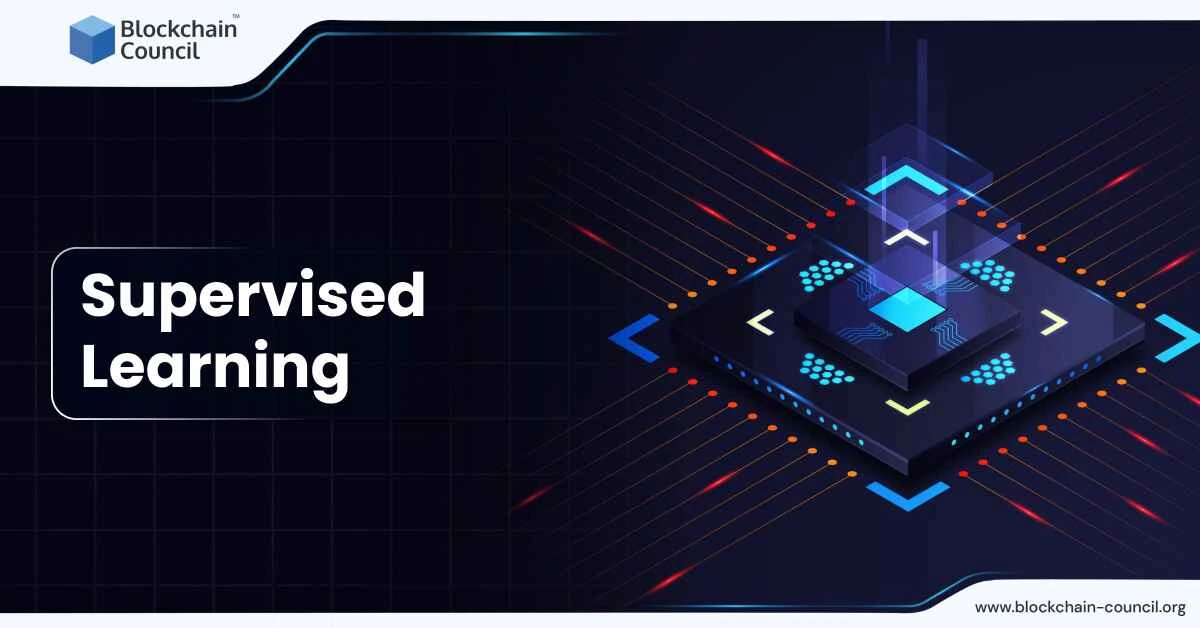
- Blockchain Council
- September 15, 2024
Supervised learning is a fundamental method in machine learning. In this approach, algorithms are trained with labeled data, which means every input is paired with a related output.
This method is similar to how a student learns from a teacher, receiving feedback and adjusting their understanding accordingly. Supervised learning is frequently applied in tasks related to classification and prediction, making it highly valuable in many practical situations.
How Supervised Learning Works
The procedure starts with collecting data and getting it ready. For the learning process to be efficient, data must be cleaned, structured, and properly labeled. This step involves choosing features, which are specific attributes the model uses for predictions. For instance, predicting home prices might involve features like location, property size, and bedroom count.
After preparing the data, it is divided into two parts: training and testing. The training set helps the model understand through showing what connections the inputs and outputs have. On the other hand, the testing set is used to check the model’s performance on new, unseen data, ensuring the learning is applicable beyond the initial set.
In the training phase, the model predicts and tweaks its parameters by comparing predictions with actual results. This adjustment depends on a loss function, which evaluates the model’s performance. By consistently adjusting according to this error, the model gradually enhances its accuracy in predicting outcomes for new data.
Categories of Supervised Learning
Supervised learning typically falls into two main types: regression and classification.
Regression
Regression methods are used when the expected output is a continuous number. These methods forecast numerical outcomes using input data. A typical example involves predicting property prices based on elements such as size, location, and room count. The aim is to find the best curve or line representing the relationship between inputs and outputs.
Linear Regression is a basic technique that creates a link between the dependent variable and one or more independent variables by fitting a straight line. For instance, when predicting sales based on previous data, the algorithm identifies the line that most accurately reflects the trend.
Classification
Classification algorithms apply when the output is categorical, meaning the data gets sorted into specific groups. For example, deciding if a message is ‘spam’ or ‘not spam’ is an example of a classification issue. The model learns from labeled data and applies this learning to classify new, unlabeled information.
Logistic Regression is a widely used method for classification that predicts two possible outcomes, like yes/no or true/false. It calculates probabilities and categorizes new data based on these values, often used in tasks like detecting spam.
Popular Algorithms in Supervised Learning
Several algorithms frequently appear in supervised learning, each bringing distinct strengths for particular tasks:
- Decision Trees: These split data based on rules developed from input features, making them straightforward for both classification and regression.
- Random Forests: This technique uses several decision trees together. It improves prediction accuracy while reducing overfitting chances.
- Support Vector Machines (SVM): SVMs are particularly useful in classification tasks, finding the optimal boundary that divides classes, especially when data isn’t linearly separable.
- k-Nearest Neighbors (k-NN): This basic algorithm classifies points by evaluating the most common label among the closest neighbors, suitable for classification.
- Neural Networks: Modeled after the structure of the human brain. These are effective in managing complex tasks like image and speech recognition. However, they need significant computational power.
Real-World Applications of Supervised Learning
Supervised learning finds applications across many fields, proving its adaptability and effectiveness:
- Image Recognition: In computer vision, these models identify and categorize objects within images, such as recognizing cars or people in autonomous vehicles.
- Spam Detection: This classic use of supervised learning identifies emails as spam or non-spam based on historical data, learning the patterns typical of spam messages.
- Sentiment Analysis: Businesses use this to assess customer opinions by training models on labeled reviews, helping to understand public sentiment and refine their strategies.
- Medical Diagnosis: In healthcare, supervised learning predicts diseases using patient data, such as analyzing symptoms and history to estimate condition likelihood, supporting medical decisions.
- Credit Scoring: Financial institutions use it to assess risks related to lending. Models assess elements such as credit history to estimate the probability of a loan default occurring.
- House Price Prediction: By examining factors such as location, size, and room count, models can estimate house prices. Regression methods are often used for continuous predictions.
- Medical Classification: Supervised learning supports diagnosing conditions. Models analyze data such as age, symptoms, and test outcomes to assess if a patient has a particular disease.
Conclusion
Supervised learning is a valuable method for solving varied problems by learning from labeled data. Its applications range from simple tasks like email sorting to complex uses in medical diagnostics, making it a crucial aspect of modern technology. Understanding its functions and broad applications reveals its impact on various industries and everyday tech.





































































 Guides
Guides News
News Blockchain
Blockchain Cryptocurrency
& Digital Assets
Cryptocurrency
& Digital Assets Web3
Web3 Metaverse & NFTs
Metaverse & NFTs
